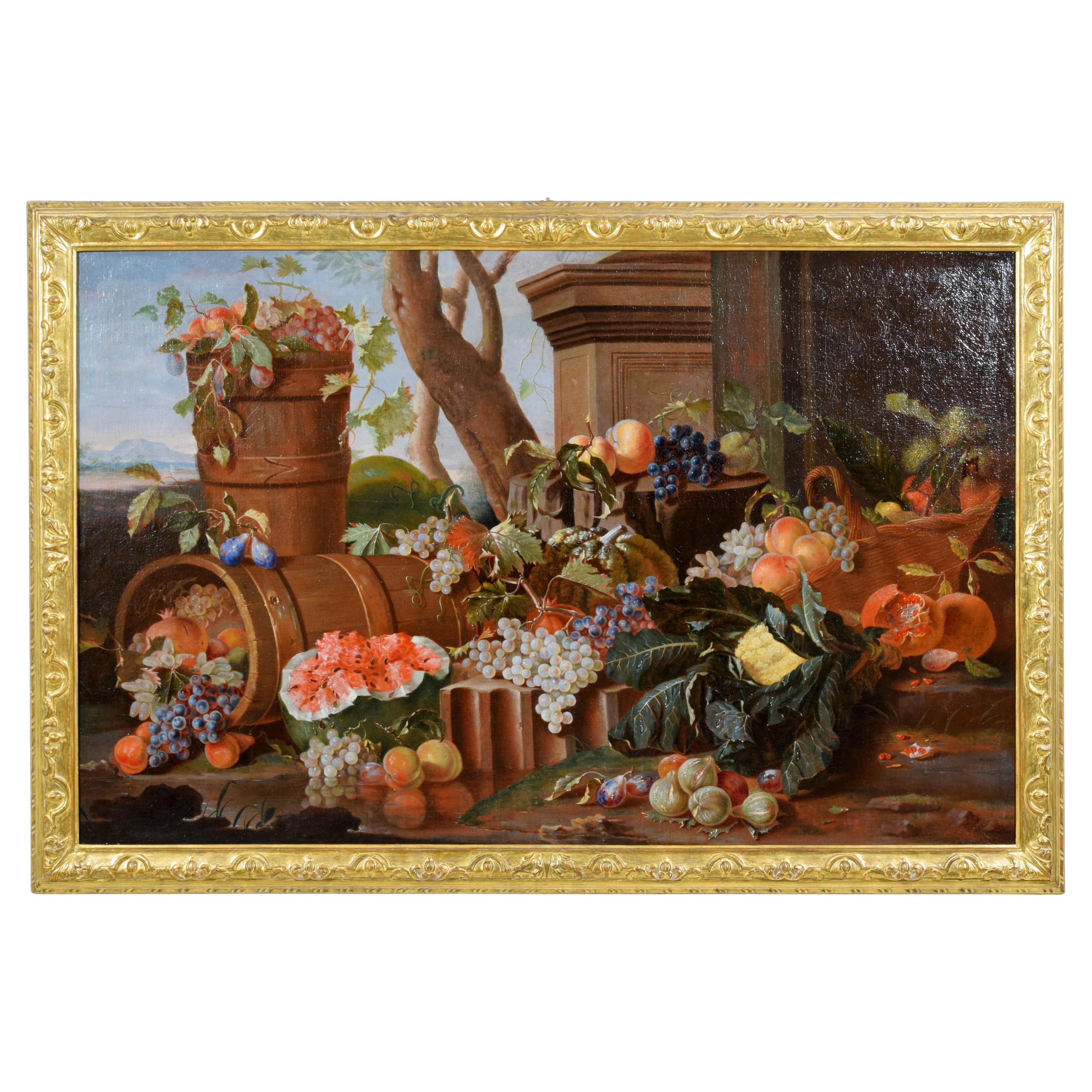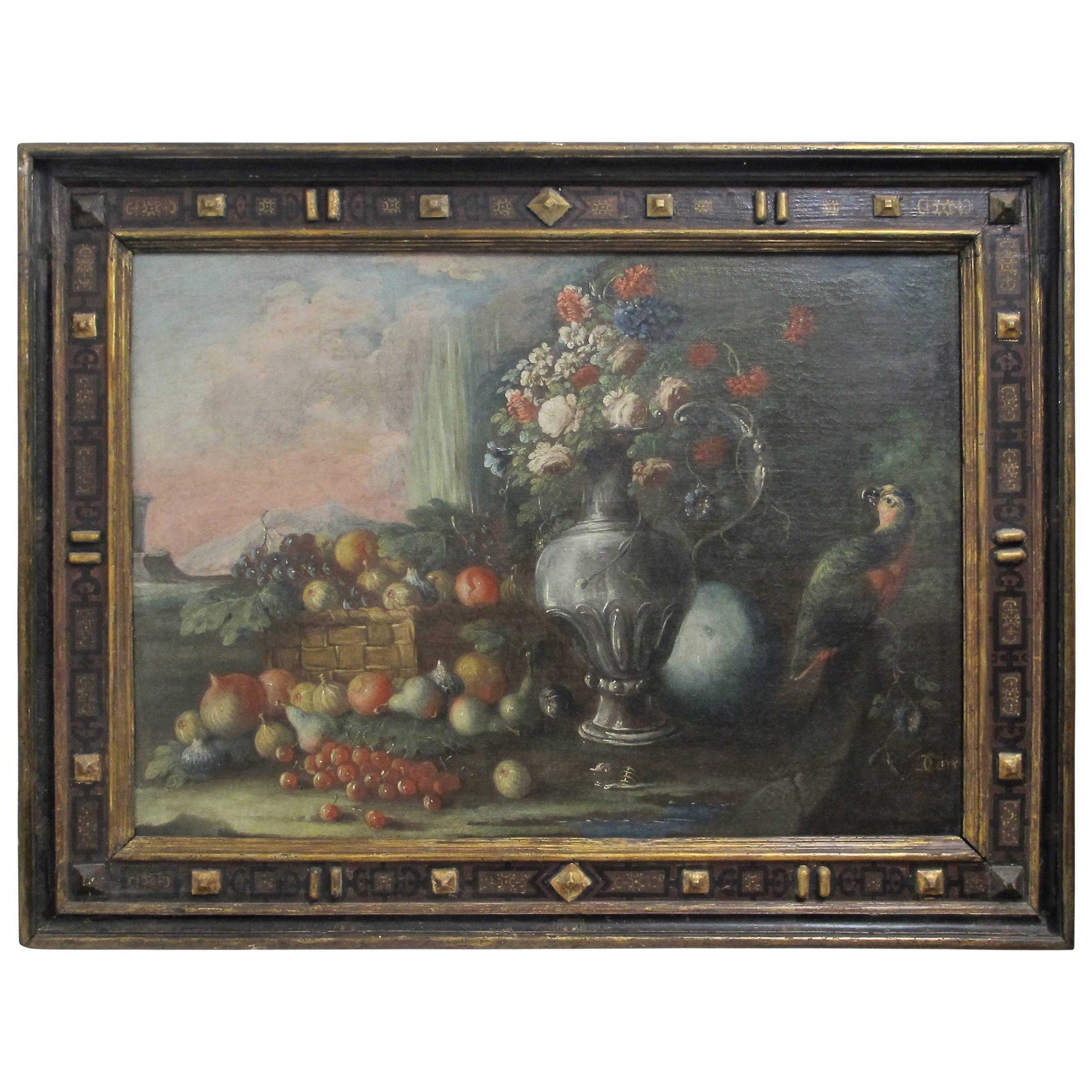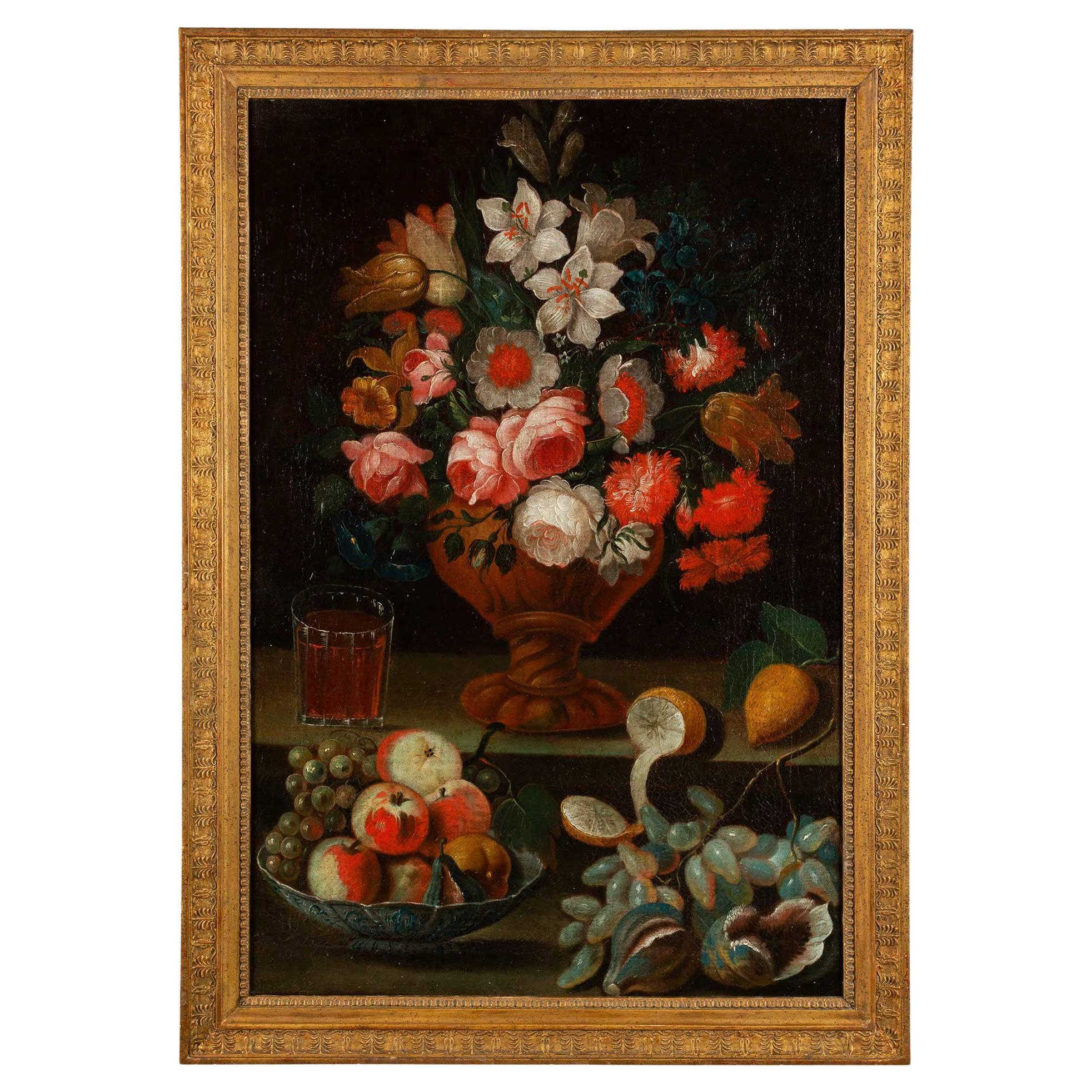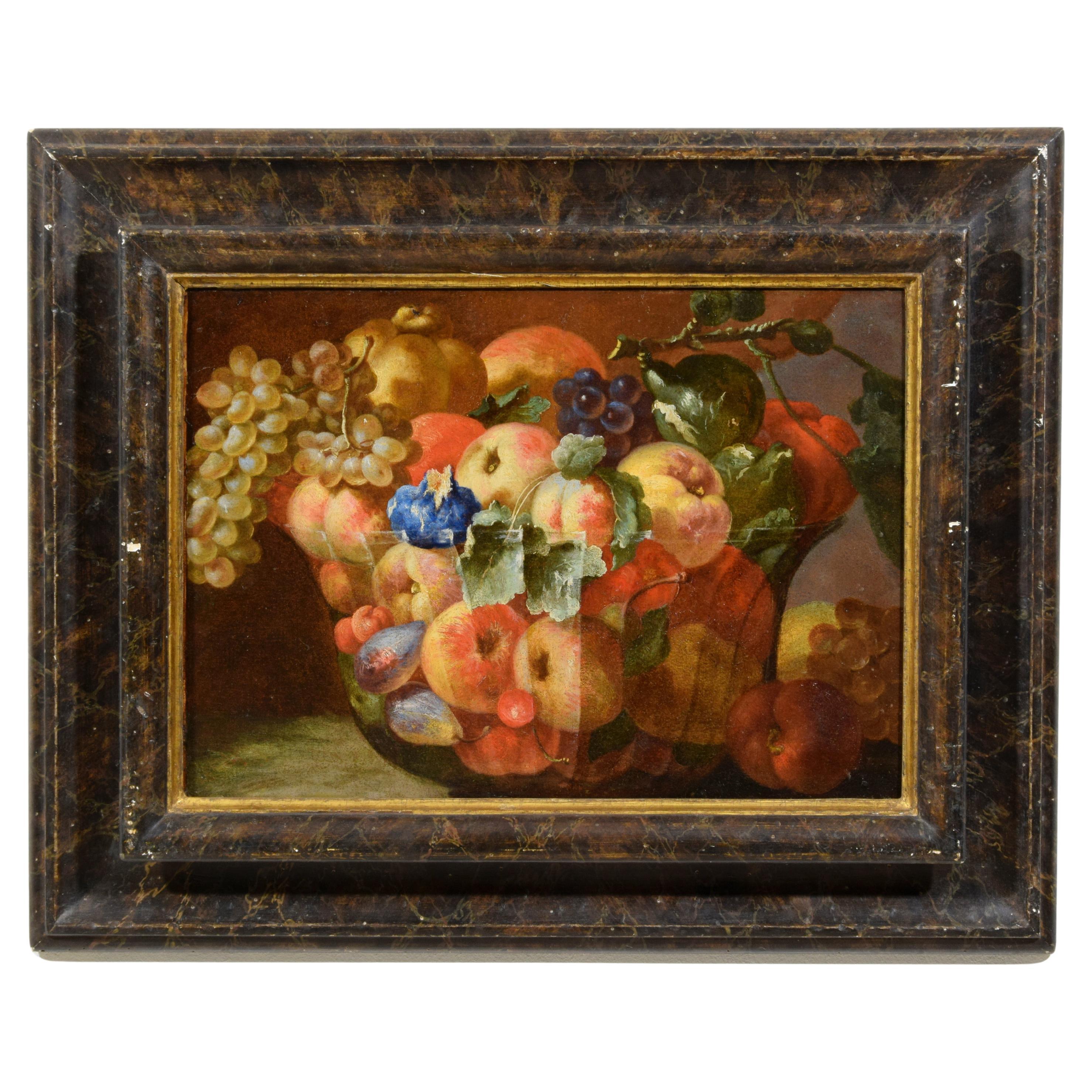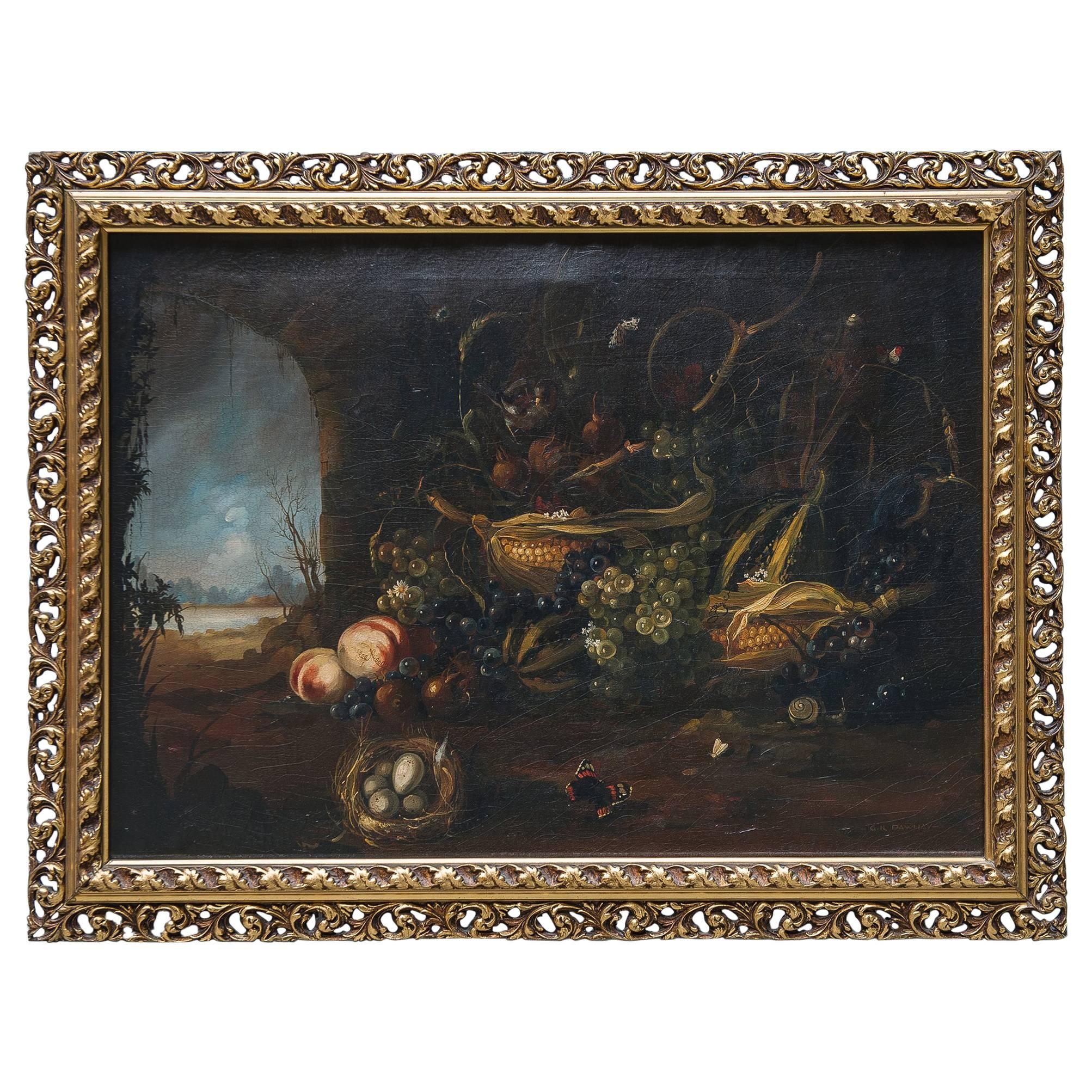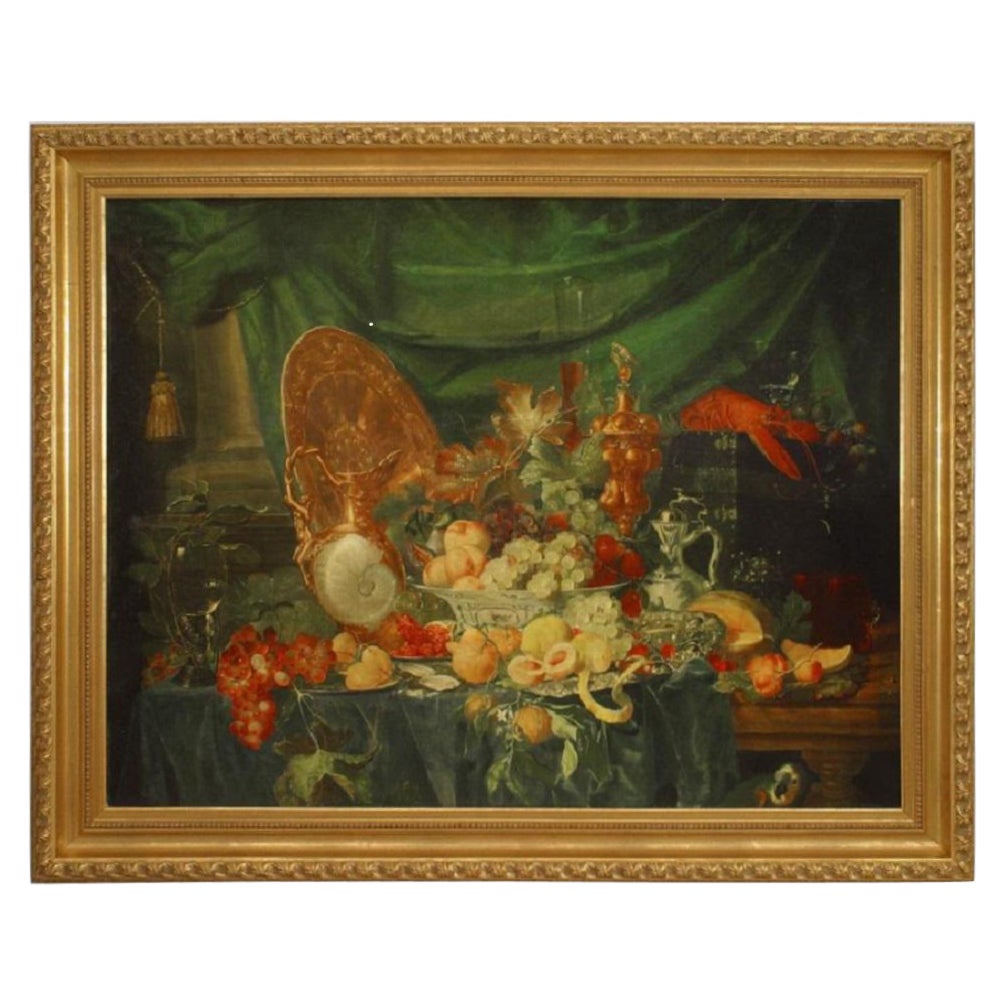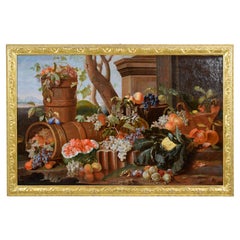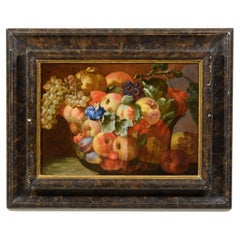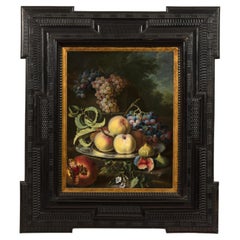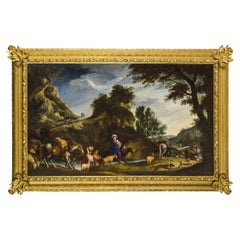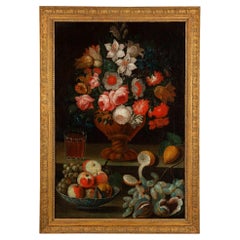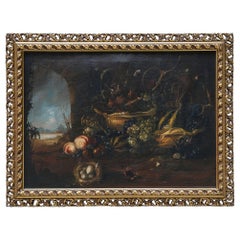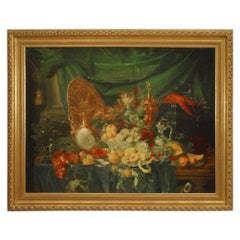Items Similar to 17th Century, Italian Painting with Still Life with Fruit, Dogs and Cat
Want more images or videos?
Request additional images or videos from the seller
1 of 20
17th Century, Italian Painting with Still Life with Fruit, Dogs and Cat
$21,817.20
£16,330.72
€18,500
CA$30,026.68
A$33,467.87
CHF 17,559.44
MX$408,697.21
NOK 222,340.70
SEK 210,145.78
DKK 140,835.03
About the Item
17th Century, Italian painting with still life with fruit, dogs and cat
Measurements: With frame cm W 93 x H 75.5 x D 4; Frame cm W 82.5 x H 66.5
The painting, made in oil on canvas, is stylistically attributable to a painter active in Italy in the seventeenth century.
The work depicts a still life composed on a table covered by a tablecloth: inside a wicker basket are placed some peaches, some white and black grapes and some white flowers. On the top are described pears, plums, a pomegranate and some donuts, “taralli” and a slice of nougat.
On the right in the foreground, a little dog with long white hair and wavy looks at a cat, sporting a precious collar with stones and red bow. This detail reveals a noble client or rich burgher, who loved to have his pet portrayed, which often was accompanied by luxurious accessories worthy of the prestigious residence in which he lived. In the background, another little dog sits on fluffy red and blue slights. On a wall that acts as a background, a cat cautiously observes the dog with the collar, while on the right a column with a grooved stem acts as the fifth composition. Between the wall and the wicker basket the author inserts the trunk of a tree with some branches of leaves, which bends to the left coming out of the canvas. A trick that allows you to create more three-dimensionality and movement to the scene. The sky that surrounds the elements described is a bright blue that recalls the blues present in the composition.
The color palette is bright and played with harmony between the shades of red, yellow, blue and green. The whole is very decorative and pleasant and the painting is suitable to be exposed in different environments such as halls and studios, entrances but also dining rooms.
In a good state of preservation, the work is undergoing historical and artistic study. The painting is mounted in a 19th-century frame, adapted to the size of the frame.
- Dimensions:Height: 29.93 in (76 cm)Width: 36.62 in (93 cm)Depth: 1.58 in (4 cm)
- Style:Baroque (Of the Period)
- Materials and Techniques:
- Place of Origin:
- Period:
- Date of Manufacture:17th Century
- Condition:Wear consistent with age and use.
- Seller Location:IT
- Reference Number:1stDibs: LU4405232768712
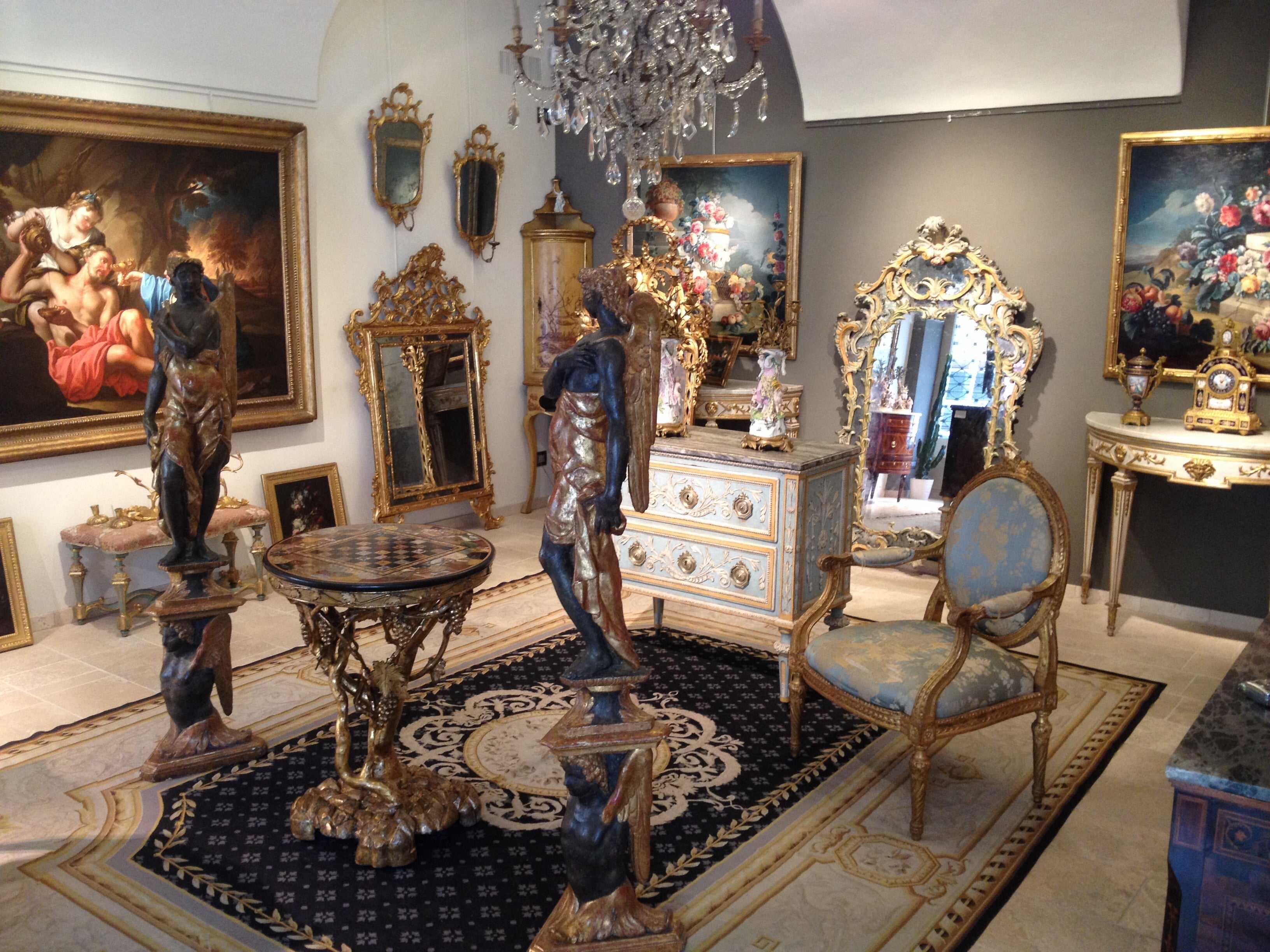
About the Seller
5.0
Platinum Seller
Premium sellers with a 4.7+ rating and 24-hour response times
Established in 1980
1stDibs seller since 2019
56 sales on 1stDibs
Typical response time: 1 hour
- ShippingRetrieving quote...Shipping from: Italy
- Return Policy
Authenticity Guarantee
In the unlikely event there’s an issue with an item’s authenticity, contact us within 1 year for a full refund. DetailsMoney-Back Guarantee
If your item is not as described, is damaged in transit, or does not arrive, contact us within 7 days for a full refund. Details24-Hour Cancellation
You have a 24-hour grace period in which to reconsider your purchase, with no questions asked.Vetted Professional Sellers
Our world-class sellers must adhere to strict standards for service and quality, maintaining the integrity of our listings.Price-Match Guarantee
If you find that a seller listed the same item for a lower price elsewhere, we’ll match it.Trusted Global Delivery
Our best-in-class carrier network provides specialized shipping options worldwide, including custom delivery.More From This Seller
View All18th Century, Italian Oil on Canvas Still Life by Pietro Navarra
Located in IT
18th century, Italian oil on canvas still life by Pietro Navarra
Oil on canvas, canvas measures: cm H 103 x W 164, framed measures...
Category
Antique 18th Century Italian Baroque Paintings
Materials
Canvas
$51,983 Sale Price
20% Off
18th Century, Italian Painting Still Life by Giovanni Paolo Castelli Lo Spadino
Located in IT
Giovanni Paolo Castelli, known as "Lo Spadino" (Rome 1659 – around 1730)
Still Life with a Composition of Fruit
Dimensions: frame cm L 76.5 x H 61 x D 6.5. Canvas cm L 55.5 x H 40
Th...
Category
Antique Early 18th Century Italian Baroque Paintings
Materials
Canvas, Wood
18th Century, Painting with Still Life by Maximilian Pfeiler
Located in IT
Maximilian Pfeiler (active Rome, circa 1694-circa 1721 Budapest)
Still life with peaches, grapes, figs and pomegranate
Oil on canvas, Measures: cm H 63,5 x W 47. With frame cm ...
Category
Antique Early 18th Century Italian Baroque Paintings
Materials
Canvas, Wood
17th Century, Italian Painting by Pier Francesco Cittadini, Jacob and his Family
Located in IT
Pier Francesco Cittadini (Milan, 1616-Bologna, 1681)
"Jacob and his family go to Egypt"
Oil on canvas, cm 109 x 190 (canvas only)
The valuable painting, made in oil on canvas, depicts Jacob and his family go to Egypt and we believe it can be, given the high quality painting, autograph work of Italian Pier Francesco Cittadini (Italy Milan, 1616 - Bologna, 1681) made after 1647. The work, in excellent condition is accompanied by a coeval frame in wood finely carved and golden.
The scene depicted, which was confused with the Flight to Egypt in the past years, is instead identified with the biblical episode of Jacob’s journey. In the foreground, reading the painting from left to right, we see a caravan composed of animals, including donkeys, dromedaries, goats, dogs and horses and people, women, men and slaves, who carry on their journey along the banks of a river, following a path that to the right, would seem to lead to the through of a bridge. In addition to the watercourse is described an environment characterized by large rocks and impervious come far to cover the entire verticality of the canvas. On the left, in the distance, we see the tail of the caravan that runs along the steep path. Large trees enliven and harmonize the environment, as well as white and grey clouds characterize the predominantly clear sky and illuminated on the right by sunlight.
The story is told in the Bible, Book of Genesis, 30, 25, passage in which is described the flight of Jacob from Haran after the contrasts with Laban, father of his wife Rachel. Jacob is the third great patriarch of the Bible. From his descendants originate the twelve generations of the people of Israel. He is the son of Isaac and Rebekah, who led him to flee from the wrath of Esau to Haran to seek refuge from his brother, Laban. At his uncle’s house Jacob met his daughter Rachel. As soon as he saw his cousin, Jacob was taken. Jacob will stay seven years in the service of Laban to marry his beloved Rachel. But Laban, with a deception, will give him in marriage first Lia, the least beautiful eldest daughter, and only after another seven years the splendid Rachel. From his first wife he will have several children, while Rachel will give birth to the beloved son, Joseph, who will become viceroy of Egypt.
After years of service, Jacob asked to be paid with every dark-coloured garment among the sheep and every spotted and dotted garment among the goats. Laban accepted and sent away from his sons all the leaders of that kind. So Jacob took fresh branches of poplar, almond and plane tree, and flayed them, and put them in the troughs. The optical suggestion induced the goats and the sheep to conceive and give birth to dark, striped and dotted garments. He also ensured that all the strongest and healthiest leaders of the flock of Laban would drink near the barked branches, thus assuring a genetic superiority to his part of the flock. His flocks grew numerous and strong and he became richer than his relative, arousing envy. It was clear that Laban would not respect him much longer. At the suggestion of the Lord, Jacob decided to return to Canaan. Trying to avoid any possible dispute, he left with his family while Laban was absent for shearing sheep. But when, three days later, his uncle returned home, he became angry, feeling offended because Jacob had gone secretly and had not allowed him to greet his daughters and grandchildren. In addition, his teraphim, statuettes, or idols, which depicted the family deities, had disappeared. After 7 days of pursuit, Laban and his men reached Jacob’s group on Mount Gilead, in the mountainous region west of the Euphrates River, where his uncle and grandson had a stormy conversation. The younger man was outraged at being accused of stealing idols and told Labano to rummage through his family’s tents at will. Neither of them could know or even imagine that it was Rachel who took the idols and hid them in the saddle of the camel. During the search, she sat down firmly on the saddle, apologizing for not being able to get up, «because I usually have what happens to women» (Gen 31:35). So the loot wasn’t discovered.
The author of this work was inspired by the composition of an engraving by Stefano Della Bella (1610-1664) of circa 1647. The engraving by Stefano della Bella bears the title "Iacob sur ses vieux jours quitte sans fascherie pour voir son filz Ioseph, sa terre et sa patrie" and is signed on the bottom left "Stef. of the Beautiful In. et fe." while on the right it is declared "Cum privil. Regis", that is with license of the king.
Stefano Della Bella (Italy - Florence, May 18, 1610-Florence, July 12, 1664) was born in a family of painters, sculptors and goldsmiths and was left early orphan of his father sculptor, he dedicated himself first to the art of goldsmith at the school of Giovanni Benedetto Castiglione and Gasparo Mola, then turning his attention to drawing and engraving. He soon began drawing figures and copying the etchings of Jacques Callot, which inspired his early works. Under the protection of the Medici, in particular of Don Lorenzo, cadet son of Grand Duke Ferdinand I, Della Bella has the opportunity to make study trips to Rome, where he stayed from 1633-1636; In Rome he met French engravers and publishers of prints such as Israël Henriet and François Langlois, who influenced his decision to move to Paris in 1639, four years after the death of Callot. In Paris he soon reached, thanks to the engravings commissioned by Cardinal Richelieu, the success also worldly; he frequented courtiers, theatre artists and writers, while refusing too oppressive honors. In 1646-1647 he continued his travels in the Netherlands to Amsterdam, Antwerp and Dordrecht. He returned to Florence in 1650 and resumed working under the protection of the Medici court, working for his patrons. In 1656 he became a member of the Academy of Apatists.
The painting object of this study is reasonably attributable to Pier Francesco Cittadini, or Pierfrancesco Cittadini, called the Milanese or the Franceschino (Italy - Milan, 1616-Bologna, 1681) as some exemplary stylistic comparisons proposed to follow can prove.
Pier Francesco Cittadini was an Italian baroque painter, mainly active in Bologna.
His artistic training first took place with the painter Daniele Crespi...
Category
Antique Mid-17th Century European Baroque Paintings
Materials
Canvas, Giltwood
18th Century, Italian Still Life Painting Attributed to Francesco Lavagna
By Francesco Lavagna
Located in IT
Francesco Lavagna (Italy -Naples 1684-1724)
"Still life with flowers and watermelon and hermas with garden in the background"
The painting, beautifully made and in good condition, d...
Category
Antique Early 18th Century Italian Baroque Paintings
Materials
Canvas
$17,453 Sale Price
20% Off
18th Century, Pair of Italian Still Life Painting, attr. to Francesco Lavagna
By Francesco Lavagna
Located in IT
Francesco Lavagna (Italy, Naples 1684-1724)
Pair of paintings depicting Still Life composition of flowers and watermelon and garden in the background
The paintings, beautifully mad...
Category
Antique Early 18th Century Italian Baroque Paintings
Materials
Canvas
$27,882 Sale Price
20% Off
You May Also Like
18th Century Italian Still Life Painting
Located in San Francisco, CA
Beautifully executed large-scale still life painting with overflowing fruit, flowers and a parrot. Oil on canvas, in carved, painted and gilt period frame. Signed in lower right corn...
Category
Antique Early 18th Century Italian Paintings
Materials
Canvas
Italian 17th Century Oil on Canvas Still Life, from Rome
Located in West Palm Beach, FL
A stunning Italian 17th century oil on canvas still life, from Rome. The painting depicts a beautiful fruit bowl and grapes in the foreground and wonderfully executed bouquet of flow...
Category
Antique 17th Century Italian Paintings
Materials
Canvas, Giltwood
Italian Still Life Painting Oil on Canvas in Flemish Style
Located in Alessandria, Piemonte
Charming still life old Italian painting with beautiful details, in a vintage Italian carved wooden frame
Interesting for a study room .
If You don't want the frame for the paintin...
Category
Mid-20th Century Italian Baroque Paintings
Materials
Giltwood
Italian Renaissance Fruit Still Life
Located in Queens, NY
Italian Renaissance style still life of fruit with gold serving pieces displayed in front of a green drape in a gilt carved frame
Condition: Good; Wear consistent with age and use
Category
Late 20th Century Renaissance Paintings
Materials
Paint
17th Century Large Dutch Painting Still Life with Fruit and Game, Oil on Canvas
Located in Vero Beach, FL
This large, old master still life painting is a perfectly balanced composition of fruit and game birds. In the foreground a rabbit is stretched out. A copper kettle and a basket are ...
Category
Antique 17th Century Dutch Baroque Paintings
Materials
Canvas, Paint
Italian Still Life Painting of a Cat with Game
Located in Essex, MA
Relined canvas depicting birds prepared for dining with table and cat peeking out considering dining himself with live roosters in the background and copper pot filled with vegetables.
Category
Antique 1690s Italian Paintings
Materials
Canvas
